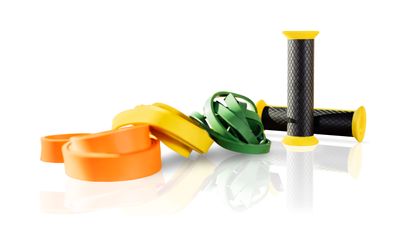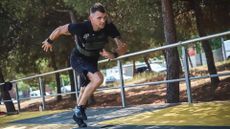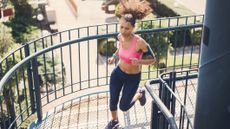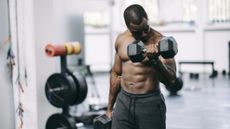Resistance bands weren’t so well known before lockdown but have rocketed in popularity since, mostly thanks to the 'new normal' of working out at home. As a result, they have quickly become a staple purchase for most fitness fanatics.
Offering a great alternative to free weights, the best resistance bands are small enough to store away or take with you to just about anywhere and definitely much cheaper than a set of dumbbells.
While resistance bands are quite simple in that they are literally just a loop of stretchy material such as latex, buying the right ones for your particular exercise regime isn’t quite as straightforward.
Any Google search will quickly determine just how many bands – of all shapes and sizes – are available on the market these days; it’s pretty exhaustive. For one, they come in different colours, shapes, sizes and accessories.
With that, here are some key factors to think about when considering your purchase of a resistance band set...
Different types of resistance bands
Choosing the right resistance band for your specific fitness needs isn’t as easy as you’d think. There are many different bands available, but there are hoards of brands producing very similar offerings. The first thing to note is that there are five main types of bands. These are power resistance bands, also known as loop bands that are kind of like a huge elastic band, tube resistance bands with handles, mini-bands also known as hip circle bands, therapy resistance bands, which are designed for lower impact activities like pilates, and then finally figure-eight bands.
Tube resistance bands are thin latex bands that come with a carabiner-esque clip at each end. This allows them to be attached to various accessories, such as handgrips, ankle straps and door anchors.
Power resistance bands, or “loop bands”, are probably what first comes to mind when you think of resistance bands. Usually made out of latex or rubber, they form a 'complete' loop with no break in the material. As the name suggests, these types of bands are ideal for looping around your thighs or ankles to add load when performing leg workouts.

Power resistance bands in use
Mini-bands or hip-circle bands are similar to rower resistance bands, except they are much shorter and wider. They are usually placed just above the knee in exercises to target your glute medius muscle, a small hip abductor muscle on the outer side of each butt cheek.
Therapy bands are also similar to power resistance bands in that they are made from latex; however, they do not form a complete loop - instead, they are wider, stretchier and have two ends that people can grasp in the hands. These can be useful when completing shoulder and arm exercises and are especially useful in home Pilates workouts.
Figure-eight bands are much shorter in length and generally feature soft foam handles, which provide an easier and more comfortable grip, as well as helping to protect the band. These are best used in situations where you want to tone and strengthen muscles. They are also ideal for rehabilitation.
Although they can be bought separately, most resistance bands are offered as part of a set of three or five, and sometimes even more. If you’re new to resistance bands, we’d recommend starting with a set as you’ll get a good range of resistance levels, from beginner to pro, which can be used for different workout scenarios.

Colour-coded resistance levels
When shopping for resistance bands, the first thing you’ll notice is that they come in different colours. Each of these colours represents different levels of resistance.
While most band makers conform to the same colour coding, be aware that this can differ slightly between brands as there's no industry rule for what resistance a particular colour represents. To understand the resistance levels, you'll need to look at the coding of the bands you purchase. Nevertheless, here’s what you can generally expect from most companies:
At the lower - or 'light' - end of the scale, you'll typically find bands with a resistance level of around 5 - 10lbs (2.3 - 4.6kg, whilst the 'heavy' (or even 'extra heavy') bands might sit around the 25 - 30lb (11.4 - 13.6kg) mark.
Normally, you’d use the bands with heavier resistance for those exercises where you need some stability, for example, assisting your squats. Alternatively, lower resistance levels are better suited to workouts where you're pushing against the band with lots of reps, for example, leg extensions.

Resistance band accessories
One key to using bands is having different ways to attach them. Different resistance band sets will come with different attachments, so it's worth checking what you’ll receive in the pack before ordering, as some attachments won’t be for everyone.
For example, if you have something stationary in your house (that will not move when pulled, such as a bannister rail, etc, that you can wrap a band around for exercises like chest presses or seated rows, you may not need any accessories.
However, those who don’t might want to ensure their kit of choice contains something like a door anchor attachment so you can easily attach it to your door and work out that way. Other accessories, such as ankle cuffs, and a range of differently shaped handles, are also available.
The best attachment we can think of is the TRX Bandit, a handle that enables you to work out more comfortably when using resistance bands. Much like resistance bands, the TRX Bandit is feather-light and takes up very little space, making it ideal for on-the-road workouts.
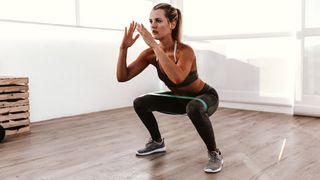
Resistance band exercises
The best way to use resistance bands is as an alternative to free weights. This is because they can help you focus your control during condition training while stabilising your muscles. But you have to be sure you’re using them the correct way to hit your muscles the correct way so that enough resistance is created to promote growth.
Most resistance bands sets come with a guidebook, a workout app, or at the very least a link to the company’s webpage where you can get help on the best way to use their bands and the top exercises to do. If not, here’s our top pick for the best resistance band workouts:
- resistance band thrusters
- resistance band push ups
- resistance band seated rows
- resistance band good mornings
- resistance band kneeling crunches
For more information regarding how to perform these exercises, how many reps and sets to do and for how long, check out our resistance band workout guide.
Resistance band carry bags
Most resistance bands sets will come with a carry bag to keep everything in one place. Most sets usually have lots of small accessories and loose fixtures; we definitely recommend buying one if you didn’t get one included.
Resistance band price
So, how much will a pack of resistance bands set you back? Luckily, it shouldn’t be that much at all, especially when compared to the price of a dumbbell set. Expect to pay from £10 up to around £30 for a decent set of bands.
As we mentioned previously, there are a lot out there to choose from, especially on Amazon and the like, so be sure to visit our best resistance bands buying guide for some help in finding the most suitable for you.
